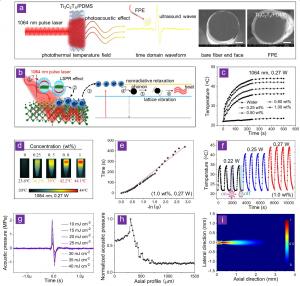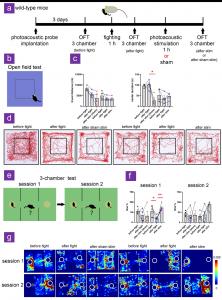Broadband ultrasound generator over a fiber-optic tip for in vivo emotional stress modulation

Fig. 1 | An implantable fiber-optic photoacoustic neurostimulator. (a) Schematic illustration of the FPE. (b) Broadband ultrasonic excitation of FPE, b1: time-domain and frequency-domain ultrasound response of FPE, b2: lateral distribution of FPE sound fi
Ultrasound neuromodulation, as a technique for controlling neural activity, has garnered increasing attention in recent years.
CHENGDU, SICHUAN, CHINA, June 20, 2025 /EINPresswire.com/ -- Check out the full article here: https://www.oejournal.org/article/doi/10.29026/oes.2025.240034Emotional stress, a common form of tension in daily life, can disrupt the body’s homeostasis. Beyond affecting peripheral organ functionality, maladaptive and uncontrollable responses to emotional stress may contribute to central nervous system disorders such as anxiety, post-traumatic stress disorder (PTSD), epilepsy, and ischemic stroke. Multiple brain regions in mammals are involved in coping with emotional stress, including the prefrontal cortex (PFC), amygdala, anterior insula, hippocampus, and striatum. Human neuroimaging evidence suggests that the medial prefrontal cortex (mPFC) is a critical locus within the adaptive behavioral coping circuit, regulating anxious emotions. Under emotional stress, the activation of the stress, immune, and oxidative systems can converge into a state of mutual activation, potentially leading to behavioral and biochemical changes, thus forming a vicious cycle.
Ultrasound neuromodulation, as a technique for controlling neural activity, has garnered increasing attention in recent years. However, when transmitted externally, ultrasound encounters significant scattering and reflection due to the skull's high acoustic impedance, potentially leading to off-target stimulation and even traumatic, irreversible brain injury. A miniature fiber-optic photoacoustic emitter (FPE) featuring controllable ultrasonic intensity and broadband is of great significance for achieving high spatial precision reversible neural stimulation. Implantable devices enable electrical and chemical modulation of the brain, significantly advancing the precise treatment of neurological and psychiatric disorders. Nonetheless, developing a scalable implant system without electrochemically active elements that can locally reversible modulate neurons in subcortical brain regions remains a significant challenge. Fiber-optic photoacoustic neural stimulation, a novel technique leveraging optical fibers, offers a groundbreaking approach to modulating neural activity with high spatial precision and minimal invasiveness. Studies have shown that fiber-optic photoacoustic stimulation can evoke precise and controlled neural responses, opening new avenues for treating neurological disorders like Parkinson’s disease, epilepsy, and chronic pain.
The research group of Prof. Zheng-Ying Li from Wuhan University of Technology and Xing-Hua Liu from Tongji Hospital Tongji Medical College of HUST propose a broadband ultrasound generator over a fiber-optic tip for in vivo emotional stress modulation, published in early view of Opto-Electronic Science journal.
To address the aforementioned open question, we developed a diameter 200 μm miniature FPE, designed to stimulate medial prefrontal cortex neurons. This device is composed of Ti3C2Tx and polydimethylsiloxane (PDMS). The FPE employs a pulse laser to modulate the photothermal temperature field of Ti3C2Tx, resulting in periodic thermal expansion and contraction of the surrounding PDMS, which generates ultrasonic waves (Fig. 1(a)). The assembled device simultaneously achieves controllable sound intensity, broadband (-6 dB bandwidth: 162%), and high spatial precision (lateral: 163.3 m, axial: 207 m), these parameters ensure that the FPE can precisely stimulate neurons in the target area and reduce the risk of off-target effects. The FPE implantable ultrasound stimulator is electrochemically inactive, exhibits good biocompatibility, is non-genetic, and can locally reversible modulate neurons in subcortical brain regions. Furthermore, we confirmed that ultrasound stimulation of the mPFC can relieve acute SDS-induced emotional stress. We implanted two fiber-optic probes simultaneously into the mPFC of mice, one for ultrasound neurostimulation and the other for fiber photometry recording of neuronal excitability in the mPFC. Using GCaMP, a calcium indicator expressed in the mPFC, we can directly record the correlation between ultrasound neurostimulation and neuronal excitability through calcium signals (Fig. (1c)). The functionalities demonstrated by our developed FPE stimulator offer a highly promising approach for neuromodulation therapies in the treatment of neurological and neuropsychiatric disorders.
In summary, FPE provides a high spatial precision and reversible neural stimulation method applicable to neurological research in specific brain regions. This study highlights the potential of FPE in addressing stress-related psychiatric disorders. Its fabrication flexibility and enhanced electromagnetic compatibility facilitate clinical applications, including Parkinson's disease, epilepsy, chronic pain, and mood disorders.
This paper was collaboratively completed by researchers from Wuhan University of Technology and Tongji Hospital Tongji Medical College of HUST.
National Engineering Research Center of Fiber Optic Sensing Technology and Networks of Wuhan University of Technology is the only national-level innovation platform for fiber optic sensing in China. It has received two National Technological Invention Second Prizes, two National Science and Technology Progress Second Prizes, and 33 provincial and ministerial-level science and technology awards, making outstanding contributions to national and regional economic development, social progress, and industry advancement. The "Intelligent Optoelectronics" team of the center, guided by Academician De-Sheng Jiang, an expert in fiber optic sensing, consists of multidisciplinary researchers from information technology, materials science, optoelectronics, and mechanical engineering. The team leader, Professor Zheng-Ying Li, is a National "Ten Thousand Talents Program" Young Top Talent and has received the "National May 1st Labor Medal" and "National Role Model for Youth" honors. He has also been funded by the Hubei Provincial Outstanding Young Scientist Fund and enjoys a special allowance from the Hubei Provincial Government.
The team has conducted in-depth research on fiber optic sensing demodulation, high-capacity fiber grating fabrication, special fiber fabrication, and signal processing. In the past five years, they have led more than 20 national-level research projects, including those funded by the National Key R&D Program and the National Natural Science Foundation of China. They have published over 90 papers in prestigious international and domestic academic journals and conferences. The team is actively engaged in industry-academia-research collaboration, conducting cutting-edge innovation research to promote the transformation of scientific and technological achievements, and their research has been widely applied in fields such as healthcare, petrochemical industry, rail transportation, and electric power.
Xinghua Liu is an assistant researcher in the Department of Trauma Surgery, Tongji Hospital, Tongji Medical College, Huazhong University of Science and Technology. His main research interests include the mechanism of cognitive impairment related to Alzheimer's disease, neuroimmunity and the mechanism of action of neural circuits. He is good at in vivo electrophysiological recording and analysis, animal behavior research using artificial intelligence, and proficient in Python programming. He has published more than 30 papers in journals such as Neuron, Brain, Behavior, and Immunity, including 1 paper with high ESI citation.
Andrew Smith
Charlesworth
+44 7753 374162
marketing@charlesworth-group.com
Visit us on social media:
LinkedIn
YouTube
Other
Legal Disclaimer:
EIN Presswire provides this news content "as is" without warranty of any kind. We do not accept any responsibility or liability for the accuracy, content, images, videos, licenses, completeness, legality, or reliability of the information contained in this article. If you have any complaints or copyright issues related to this article, kindly contact the author above.

